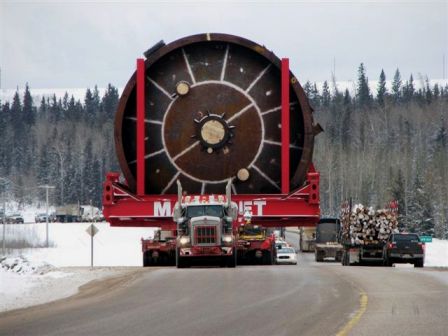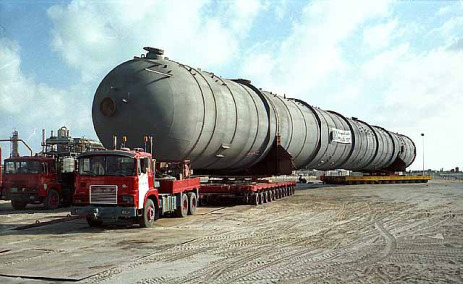 Now that’s a Mammoth truck.A new scheme threatens to tear up Montana to facilitate tar-sands oil extraction in Canada.
Now that’s a Mammoth truck.A new scheme threatens to tear up Montana to facilitate tar-sands oil extraction in Canada.
Imperial Oil (you couldn’t make up a name like that) has contracted with the Dutch company Mammoet (meaning “mammoth,” another apt name) to transport giant machines from South Korea through Idaho and Montana to Canada’s Athabaskan tar-sands project in Alberta.
Imperial, which is 69.6 percent owned by ExxonMobil, has proposed to Montana that an initial round of 200 giant machines creep through the state almost daily and nightly for a year. Some of the machines weigh 334,000 pounds and measure 24 feet wide by 30 feet tall by 160 feet long.
The proposed route would avoid any overpasses or underpasses, eliminating the need for complicated and pricey reconstruction projects. But it would require giant new highway turnouts, scheduled to be built before the trucks start traveling late this fall.
Imperial is speed-rushing a permit through the Montana Department of Transportation (MDOT). Montana decided that this was not a federal issue, that there was insufficient controversy for it to be considered for federal review. (By what formal means this decision was made is unclear.) The state opted to evaluate the proposal with a quick and easy Environmental Assessment, rather than a federal Environmental Impact Statement. Montana then contracted with Imperial Oil to produce that assessment, which declared there would be no impact.
The machines would be shipped from South Korea to Vancouver, Wash., then barged up the Columbia River to the inland port of Lewiston, Idaho, where they would then begin their dryland sojourn up the historic Lolo Pass, along the fabled steps of Lewis and Clark, and the winding recreational corridor of the beautiful Lochsa River.
The desolate Montana border crossing of Sweetgrass is the goal of the advancing army of Mammoet. From there, the monster machines would make it to the sanctity of Canada, where the government is condoning the largest and most destructive surface mining in the world.
The terror of the tar sands
Tar-sands operations extract oil by squeezing and boiling and steaming heavy tar out of porous sands, like wringing a sponge. Due to the steam and water and fuel involved, tar-sands oil results in 45 percent more carbon emissions than oil from traditional drilling.
There are nearly 2 trillion barrels of tar-sands oil lying beneath Alberta — which is being bladed away, mile by mile, as we dig to get at those sands. It’s a liquidation, in every sense of the word. But, as with coal, the true cost of the resource is not being measured or accounted for. ExxonMobil benefits, as do its lesser partners, but everyone else carries the oil companies’ externalized costs, now and forevermore.
Take the First Nations people of Canada. A number of them are being displaced by the mining, and are “suffering all the hallmarks of industrial poisoning, everything from birth defects to environmentally linked cancers — in heartbreaking proportions,” says Missoula attorney Bob Gentry.
The tar sands’ footprint is so huge that some have called the project the biggest environmental crime in history. The ecological damages include gigantic mine pits, ponds of toxic mine waste, destruction of the world’s largest intact forest, and threats to populations of birds and other animals.
Montana rolls over
 Did we mention these loads are large? The governor of Montana, Brian Schweitzer (D), appears willing to squander the state’s singular reputation as an idyllic vacation spot, free from the congestions of traffic and stress that other travelers expend so much effort to escape, and to green-light the loads of Mammoet in all seasons.
Did we mention these loads are large? The governor of Montana, Brian Schweitzer (D), appears willing to squander the state’s singular reputation as an idyllic vacation spot, free from the congestions of traffic and stress that other travelers expend so much effort to escape, and to green-light the loads of Mammoet in all seasons.
Schweitzer insists that this is just a one-time deal, that these 200 trucks will be the beginning and end of the tar sands’ traffic, even while at the same time touting Montana, and the proposed industrial highway expansions, as an energy corridor. “Montana is in the middle of one of the most important energy corridors on the planet,” Schweitzer says, “not just because we have wind energy and we have oil and gas and coal, but because our neighbors have all of those as well. In order to produce energy, you need to transfer energy.”
Schweitzer claims that nothing has been said about making this into a permanent industrial corridor. But a memo from his highway director, Jim Lynch, states that ExxonMobil began petitioning the state for the expansion last July, calling the route the “High/Wide Corridor,” and that the company desired “a very aggressive schedule” of construction.
What anyone familiar with the oil and gas industry knows, even if MDOT doesn’t (and you would think that Montana, with its century’s worth of shallow oil wells in the Williston Basin, would have learned by now), is that there is no end to the servicing and transportation of oilfield equipment. In the oilfield, parts and machines fail daily — big parts — and it is ridiculous to pretend that there will not be similar machines coming and going over the life of the tar-sands project, which is estimated to run for at least the next half century. Indeed, when pipelines fail, it is along these primary corridors that the oil itself may be shipped, in ceaseless high-density traffic.
And what about emergency vehicles? What happens when one of the 334,000-pound machines blows a gasket humping up over Lolo Pass and craps out, or winter-skates into the river? My guess is that it stays there forever, like an ornament, like trash: monument to a state’s folly. We don’t have a lot of 334,000-pound cranes lying around the state. There might be one somewhere up in Canada. Or maybe we can rent one from South Korea.
Anyone who claims that 200 truckloads are all that would pass over the Montana highways and back roads — along nationally designated Wild and Scenic Rivers like the Lochsa and the Blackfoot, through Indian country, along the magnificent Rocky Mountain Front, and northward — is being disingenuous.
The administrators of the port of Lewiston, Idaho, know better. They’re trumpeting that a new route has been found — a great way to give their artificial inland, salmon-killing port more business, while reducing South Korea’s external costs and maximizing South Korea’s (and Imperial Oil’s) profits.
Doug Zenner, chair of the Nez Perce County Commission in Lewiston, Idaho, chides Lochsa fishing guides like Jim Hepburn, and others who oppose the monster transports along the Lewis and Clark National Scenic Byway, for their quaint concerns about safety and quality of life. “Oh, for crying out loud,” Zenner says. “Good Lord
, get on our end of the street.”
Zenner says that with the new industrial byway, Montana’s vast (and dirty) coal deposits can now be transported through Lewiston, presumably bound for overseas, rather than traveling as they do now by rail to the mills and power plants of the American Midwest.
MDOT is defending the project — a curious stance, since the public comment period hadn’t even begun when they began advocating for it.
Everyone’s asking, What’s in it for Montana? Why is MDOT so interested in this project? Why are they willing to construct so many giant turnouts, and put up with such endless disruptions? What’s the deal?
MDOT says the turnouts will be a good thing for the state’s residents, in that they will create opportunities for cell-phone users of the future. MDOT seems to have forgotten there’s no way to provide cell coverage in those narrow canyons, nor is there coverage along the lonely, lovely winding roads tucked against the spectacular Front Range of the Rocky Mountains.
Schweitzer has already “negotiated” a $68 million contract, for about $34 million of concrete to create the industrial superhighway and $34 million for what Schweitzer describes as “flagging jobs.” He claims the deal will help keep Montana “in the black,” but the $68 million doesn’t go to the state treasury; it would instead pay for developing the High/Wide Corridor for Exxon, and for Montanans to stand on the side of the road and hold flags while the giant trucks go by.
The NOT-NOTS fight back
It seems for now that the only possible weak link in this proposed juggernaut is the college town of Missoula, home to the University of Montana, through which U.S. Highway 93 — the Lolo highway — runs. Calling themselves the NOT-NOTS (No Trucks, No Tar Sands), a diverse coalition in Missoula asked for, but did not receive, a 60-day extension for public comments. It’s also pushing for city ordinances and resolutions that would prohibit the driving of the massive trucks inside city limits. The comment period has now passed, and the state awaits a decision by the MDOT.
No one really thinks the NOT-NOTS in Missoula will be able to shut down Canada’s vast tar-sands mining operations. But they’re drawing a line in their hometown. They don’t want to carry Exxon’s and South Korea’s externalized costs.
They are trying, by working locally, at first. This is an intensely local issue, and yet intensely global.
Who makes the final decision on matters like this? The feds have jurisdiction on federal highways. The state has jurisdiction on state highways. A city ordinance most likely won’t make a difference, unless the state or federal highway becomes blocked, necessitating a detour along city roads. Mostly, an ordinance will be symbolic.
But a symbol is a powerful thing, and a good place to begin the biggest of campaigns.




